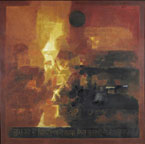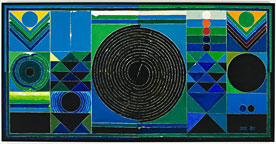Raza’s
runes: visions of the self
By Swapna Vora
July 19, 2007
(click on the small image for full screen image with captions.)
Sayed Haider Raza’s paintings with herringbone triangles, blue moons, licks of flame and inner vistas trigger transcendental experiences. India’s beloved Raza was born in central India and grew up among forests. Madhya Pradesh is far from the sea, it has hills, but not great mountains, and most of all it has had tribal princes and long waves of peace. As a child, Raza must have seen nocturnal wild creatures padding softly and dark birds flitting through damp jungles and dry forests and his early work was mainly landscapes. It was later, much later, that his handprint, or dare I say, pugmark became the ‘bindu’. Bindu is the sparkling, infinitesimal dot, the spark, the blue pearl from which worlds, (and Raza’s universe), unfurl and into which they curl back. And from bindu, says Hindu religious thought, came energy and time and space, perhaps the first light followed by the first sound.
Hindus often use the bindu to assist concentration and Raza too, as a child, was asked by his teacher to look at a dot on a wall. This helped the child’s distracted mind and presumably he never forgot its impact. Great discerning minds and creative talent want to know things, they feel ideas, taste cool voyages and touch spirit. They say softly to themselves: Where did I come from, will I, someday, know what this was all about? The poet says tell me where the candle’s light came from and I’ll tell you where it went. Indians often ponder: Is this all there is to life? How does one measure magic, alchemy? How does one tell tales of contemplation, of silence?
Raza seems to be on this quest, introspective and ultimately joyful for the hero’s quest is always for permanent bliss. His work represents the origins of life and symbols which tribal painters and highly sophisticated Indian philosophers have drawn, pondered and mulled over for millennia. His works resonate like modern tantric tankhas, inducing wonder, joy and meditation in the viewer. For me, this is not mere peace but vibration, the throb, the spanda and a peaceful, grateful homecoming to Kashmiri Shiv darshan, a glimpse of Shiv in the triangles, the points, the ascent and descent of grace. Yes, there are miracles of creation, destruction, preservation, everyone knows those. The other two miracles that Raza has are control and grace. All we can be assured of is that there is a still small point which begins and ends and begins again and which will ‘Breathe through the heat of our desire, … speak through the earthquake, wind and fire, oh, still small voice of calm’. Yes, seeing his work in silence, makes me want to bow my head and pray and slowly experience other vibrations, other dimensions. Small irregular temples, with darkened holy of holies, made long before there were religions, should hold his paintings. Perhaps these are the earliest symbols: triangles, man-woman, god, grace from man to God and back again, the six pointed stars, the vishuddh chakra. These ongoing depictions of reality streaming from Raza, need new and not so new temples, with scrolls for contemplation, and walls of carefully painted blues in flames for they induce a joyous peace and insight, when all is well and there are no more words. Rather than in a rich home, a far off cold gallery, his work would be best, to my mind, in a stone temple for us to contemplate and return peacefully downhill from a yatra, a pilgrimage. In the beginning was the dot, the unspoken sound, the unfelt, unseen vibration and we, the gods, began in a spot of light, and evolved into this wondrous universe and ended back in a dot of dust, a sparkling silence.
A journey which all of us take, sometimes with a talisman, sometimes fearful and alone, and sometimes tranquil and contemplative. Like the Magi, like SH Raza.
His Indian canvases and the early French ones were realistic, like the visible world, resembling what most of us see daily. Later he saw and painted the bindu and still later entered a white period. His primary colors of fire and the sea are the color of outer space, dark blue and yellow wherever light has become matter. Like most Indian travelers, Raza moves comfortably and familiarly between east and west, for we tend to see most other places simply as extensions of our home and ourselves.
Raza's "Cityscape" (1946) and "Baramulla in Ruins" (1948) show his sorrow and anguish over the partition of Hindustan and the suffering of Muslims in Mumbai during the riots. To be a minority, to be vulnerable and watchful, is something many the world over live with daily. Raza’s painting show towns bereft of people, voids populated by buildings and no bird sings. Lonely cityscapes, peopled perhaps by ghosts, soundlessly ask dead skeletons: Tell me now, are you still a Muslim? Are you still a Hindu?
He has spoken of
our collective anguish during and after Partition, "On the one side
there was a national tragedy. As personal history for my family, these
critical years of 1947 to 1948 were those of tragedy and separation. In
July 1947 my mother died in my house in Bombay; early in the next year
in 1948, my father passed away in Mandla. Linked with this period of riots
and killings and hatred there was my private history and my personal sense
of loss." (quoted from Geeti Sen in Bindu, Space and Time in Raza's
Vision). His paintings of Paris "Black Sun" (1953), "Haut
de Cagnes" (1951) have close clusters of homes and workplaces, hot,
uncomfortable and lonely. France taught him techniques and gave him space.
However his work is, was and continues to be remains distinctly Indian.
His new works over the years, show the spirit’s lunar and solarscape,
the eternal round, the spots, triangles and induce contemplation, serenity,
tongues of flame. Always one knows, remembers pralaya, and that everyday
is perhaps judgment day.
Syed Haider Raza’s art was rooted in the twenties, a time when Hindustan had been colonized, was totally impoverished and people yearned for freedom. Artists were tired of being told that Victorian ways and the Slade school were the correct path for them. With tribal symbols, dreams of Paris, philosophies of freedom and colors, Raza and others in the Progressive Arts Group shuffled off colonial gallows and gave birth to modern Indian art. Ancient techniques and symbols, scorned by the British, were once again surfacing and shaping India’s artists. France was valued as a teacher of technique.
S H Raza travels to India regularly to remember and drink again India and its life, its many lives. For most Indians, mainstream Hindu ideas and Muslim beliefs are everyday aspects of faith and reality, one is not alien to the other. Hence Muslims like Raza, Husain, Ghulam Rasool Santosh use Hindu symbols fluently and naturally, it is what they experienced daily. There are no strangers here or foreign issues, simply shared knowledge.
Raza spent one summer teaching in California and saw the lively delight of Pollack and the mysterious works of Rothko. However one searches in vain for any discernible influence.
 |
To me, he goes on the human’s heroic quest: why am I here, where am I going, why, what is this amazing thing called awareness, consciousness. If we hang around, will we somehow learn what it was all about? Raza paints the Bindu as the birth and sustainer of creation and existence and moves towards shapes, geometry and colour and onto two dimensional depictions of space, sound and time.
We finally have been able to draw a breath, after struggling to survive as a nation, and just create. There are few maharajas today and an artist can’t really spend precious energy cultivating patronage. And for the buyer, the enjoyer, there are plenty of unknowns who will, one day, be valued wonderfully.
Quotes:
"My inspiration has been the ideas of writers or painters and even
musicians such as the Ustad who said, 'See with your ears, hear with your
eyes.' -Sayed Haider Raza
"My work is my own inner experience and involvement with the mysteries of nature and form which is expressed in colour, line, space and light".
"The quest of the essential obsessed me. The revelation of Indian concepts, iconography, signs and symbols fortified the search. Nature as 'Prakriti', the supreme generating force, the embryonic energy contained in the seed, the male-female polarity, the ever present phenomena in Nature - germination, gestation and birth - transformed my concept of 'nature-seen' to 'nature-imagined".
"I went to France because that country taught me the technique and science of painting. The immortal artists of France like Cézanne knew the secret of the construction of a painting…. But despite my French experience, the substance of my paintings comes straight from India."
Notes: Sotheby’s Mar. 29 sold Indian and Southeast Asian art for $13,633,820 with mostly modern Indian art. Tapovan, (1972) by Sayed Haider Raza (b. 1922), sold for $1,472,000. In December 1978, the Madhya Pradesh Government, India, paid him special and grateful homage and now houses a permanent collection in Bhopal.
